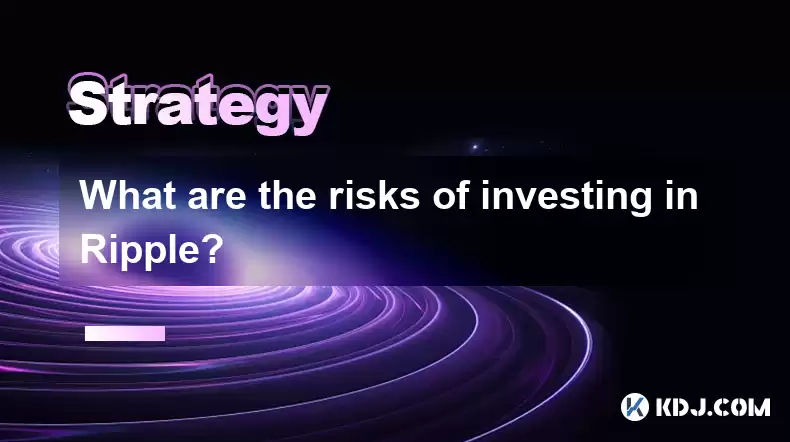-
 bitcoin
bitcoin $124586.364639 USD
0.62% -
 ethereum
ethereum $4670.671710 USD
3.33% -
 xrp
xrp $2.983701 USD
0.18% -
 tether
tether $1.000175 USD
-0.03% -
 bnb
bnb $1209.430642 USD
2.76% -
 solana
solana $231.365861 USD
0.51% -
 usd-coin
usd-coin $0.999665 USD
-0.02% -
 dogecoin
dogecoin $0.264657 USD
4.46% -
 tron
tron $0.346415 USD
1.60% -
 cardano
cardano $0.871586 USD
3.70% -
 chainlink
chainlink $23.451270 USD
7.56% -
 hyperliquid
hyperliquid $46.860071 USD
-2.96% -
 ethena-usde
ethena-usde $1.000120 USD
0.04% -
 sui
sui $3.611279 USD
1.08% -
 stellar
stellar $0.407149 USD
0.96%
What are the risks of investing in Ripple?
Investing in Ripple entails unique risks due to its centralization, SEC lawsuit, market volatility, regulatory uncertainty, liquidity concerns, counterparty risks, and operational challenges, warranting thorough evaluation before investing.
Jan 07, 2025 at 05:19 pm

- Understanding the Unique Risk Profile of Ripple
- Analyzing the XRP-SEC Lawsuit and Its Implications
- Assessing Cryptocurrency Market Volatility and Value Fluctuations
- Evaluating Regulatory Uncertainty and Compliance Challenges
- Considering Liquidity Concerns and Centralization Issues
- Recognizing Counterparty and Operational Risks
- Exploring Alternative Investment Options
Ripple is a unique cryptocurrency with a distinct risk profile compared to other digital assets. Its centralized nature, involvement in the traditional financial system, and the ongoing SEC lawsuit create unique risks for investors. Understanding these nuances is crucial before investing in XRP.
Analyzing the XRP-SEC Lawsuit and Its Implications:The SEC's lawsuit against Ripple for allegedly misleading investors has significant implications for XRP holders. The outcome of the lawsuit could determine the regulatory status of XRP, impact its value, and potentially lead to penalties or fines against the company. Investors should closely monitor the developments and seek legal advice before making investment decisions.
Assessing Cryptocurrency Market Volatility and Value Fluctuations:Like all cryptocurrencies, XRP is subject to market volatility, which can lead to significant swings in its value. Investors should be aware of this volatility and consider their risk tolerance before investing in Ripple. Value fluctuations can result from various factors, such as technological advancements, regulatory changes, and market sentiment.
Evaluating Regulatory Uncertainty and Compliance Challenges:Regulatory uncertainty surrounding cryptocurrencies remains a major risk. The SEC's increasing scrutiny of the industry, including the ongoing XRP lawsuit, creates uncertainty about the future regulatory landscape. Investors should stay informed about regulatory developments and assess the potential impact on XRP's value and legality.
Considering Liquidity Concerns and Centralization Issues:Ripple Labs controls a significant portion of the XRP supply, potentially impacting liquidity and price stability. If Ripple Labs liquidates its holdings or the market undergoes significant selling pressure, it could drive down the price of XRP. Additionally, Ripple's centralized nature may introduce additional risks compared to decentralized cryptocurrencies, such as potential censorship or manipulation.
Recognizing Counterparty and Operational Risks:Investing in Ripple involves counterparty risk with the Ripple network, exchanges, and other parties involved in XRP transactions. Operational risks, such as network outages or security breaches, can also affect XRP's value and usability. Investors should assess the reliability and security of these entities before investing.
Exploring Alternative Investment Options:Investors seeking exposure to cryptocurrencies should consider diversifying their portfolio by investing in other digital assets. This diversification strategy can help mitigate the risks associated with Ripple by reducing dependency on a single asset. Several established cryptocurrencies with proven track records offer potential investment opportunities.
**FAQs Related to the Keywords in the
Disclaimer:info@kdj.com
The information provided is not trading advice. kdj.com does not assume any responsibility for any investments made based on the information provided in this article. Cryptocurrencies are highly volatile and it is highly recommended that you invest with caution after thorough research!
If you believe that the content used on this website infringes your copyright, please contact us immediately (info@kdj.com) and we will delete it promptly.
- BlockDAG, DOGE, HYPE Sponsorship: Crypto Trends Shaping 2025
- 2025-10-01 00:25:13
- Deutsche Börse and Circle: A StableCoin Adoption Powerhouse in Europe
- 2025-10-01 00:25:13
- BlockDAG's Presale Buzz: Is It the Crypto to Watch in October 2025?
- 2025-10-01 00:30:13
- Bitcoin, Crypto, and IQ: When Genius Meets Digital Gold?
- 2025-10-01 00:30:13
- Stablecoins, American Innovation, and Wallet Tokens: The Next Frontier
- 2025-10-01 00:35:12
- NBU, Coins, and Crypto in Ukraine: A New Yorker's Take
- 2025-10-01 00:45:14
Related knowledge

Practical parameter settings for a Bitcoin multi-timeframe moving average system
Sep 18,2025 at 10:54pm
Optimizing Timeframe Combinations for Bitcoin Trading1. Selecting appropriate timeframes is crucial when building a multi-timeframe moving average sys...

How can I filter out false breakouts in Dogecoin high-frequency trading?
Sep 22,2025 at 01:00am
Understanding False Breakouts in Dogecoin Trading1. A false breakout occurs when Dogecoin's price appears to move beyond a defined support or resistan...

Techniques for identifying tops and bottoms in the Bitcoin on-chain NVT model
Sep 20,2025 at 07:54pm
Understanding the NVT Model in Bitcoin Analysis1. The Network Value to Transactions (NVT) ratio is often described as the 'P/E ratio' of the cryptocur...

What does the surge in open interest in Bitcoincoin futures mean?
Sep 20,2025 at 11:18pm
Understanding the Surge in Dogecoin Futures Open Interest1. A surge in open interest within Dogecoin futures indicates a growing number of active cont...

How can I use the Ethereum USDT premium to gauge market sentiment?
Sep 18,2025 at 11:55pm
Understanding the Ethereum USDT Premium1. The Ethereum USDT premium refers to the price difference between USDT (Tether) traded on Ethereum-based plat...

What should I do if Ethereum staking yields decline?
Sep 20,2025 at 06:18am
Understanding the Causes Behind Declining Ethereum Staking Yields1. The Ethereum network transitioned to a proof-of-stake consensus mechanism with the...

Practical parameter settings for a Bitcoin multi-timeframe moving average system
Sep 18,2025 at 10:54pm
Optimizing Timeframe Combinations for Bitcoin Trading1. Selecting appropriate timeframes is crucial when building a multi-timeframe moving average sys...

How can I filter out false breakouts in Dogecoin high-frequency trading?
Sep 22,2025 at 01:00am
Understanding False Breakouts in Dogecoin Trading1. A false breakout occurs when Dogecoin's price appears to move beyond a defined support or resistan...

Techniques for identifying tops and bottoms in the Bitcoin on-chain NVT model
Sep 20,2025 at 07:54pm
Understanding the NVT Model in Bitcoin Analysis1. The Network Value to Transactions (NVT) ratio is often described as the 'P/E ratio' of the cryptocur...

What does the surge in open interest in Bitcoincoin futures mean?
Sep 20,2025 at 11:18pm
Understanding the Surge in Dogecoin Futures Open Interest1. A surge in open interest within Dogecoin futures indicates a growing number of active cont...

How can I use the Ethereum USDT premium to gauge market sentiment?
Sep 18,2025 at 11:55pm
Understanding the Ethereum USDT Premium1. The Ethereum USDT premium refers to the price difference between USDT (Tether) traded on Ethereum-based plat...

What should I do if Ethereum staking yields decline?
Sep 20,2025 at 06:18am
Understanding the Causes Behind Declining Ethereum Staking Yields1. The Ethereum network transitioned to a proof-of-stake consensus mechanism with the...
See all articles










































































